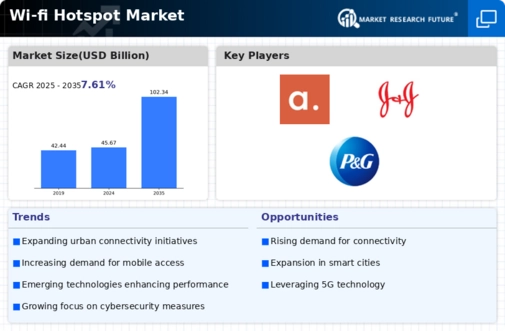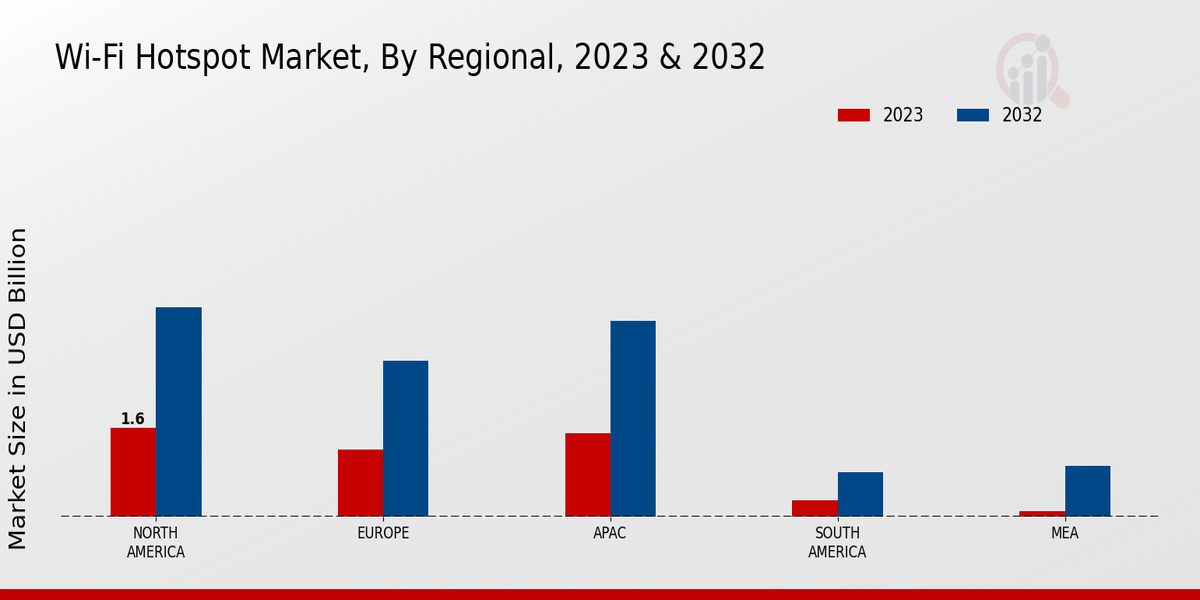Expansion of Smart Cities
The Global Wi-fi Hotspot Market Industry is benefiting from the expansion of smart cities, which integrate technology to enhance urban living. Governments worldwide are implementing smart city initiatives that include the deployment of public Wi-fi hotspots to facilitate connectivity for residents and visitors. These hotspots serve as essential components of smart city infrastructure, enabling access to services such as transportation, healthcare, and public safety. As urban populations grow, the demand for such connectivity solutions is likely to increase, contributing to a projected CAGR of 7.61% from 2025 to 2035 in the Wi-fi hotspot market.
Market Growth Projections
The Global Wi-fi Hotspot Market Industry is projected to witness substantial growth over the coming years. The market is expected to reach a valuation of 45.67 USD Billion in 2024 and is anticipated to grow to 102.34 USD Billion by 2035. This growth trajectory indicates a compound annual growth rate (CAGR) of 7.61% from 2025 to 2035. Such projections highlight the increasing importance of Wi-fi hotspots in facilitating connectivity across various sectors, including education, healthcare, and business. The ongoing advancements in technology and infrastructure are likely to further support this growth.
Increasing Internet Penetration
The Global Wi-fi Hotspot Market Industry is experiencing growth driven by the increasing penetration of the internet worldwide. As of 2024, approximately 5.3 billion people are expected to have internet access, representing a significant portion of the global population. This surge in connectivity fosters demand for Wi-fi hotspots, particularly in urban areas where public access is crucial. Governments and private entities are investing in infrastructure to support this trend, enhancing the availability of Wi-fi hotspots in public spaces. The anticipated growth in internet users is likely to propel the market towards a valuation of 45.67 USD Billion in 2024.
Growth of E-commerce and Remote Work
The Global Wi-fi Hotspot Market Industry is experiencing growth due to the expansion of e-commerce and remote work. As more businesses transition to online platforms, the demand for reliable internet access becomes paramount. Wi-fi hotspots play a crucial role in enabling remote work, allowing employees to connect from various locations. This trend is particularly pronounced in urban areas, where individuals seek convenient access to the internet while working or shopping. The increasing reliance on digital platforms is expected to drive the market forward, aligning with the broader economic shift towards online services.
Increased Focus on Digital Inclusion
The Global Wi-fi Hotspot Market Industry is also driven by an increased focus on digital inclusion. Governments and organizations are recognizing the need to bridge the digital divide by providing equitable access to the internet. Initiatives aimed at expanding Wi-fi hotspot availability in underserved areas are gaining momentum, ensuring that all individuals have the opportunity to connect online. This focus on inclusivity is likely to enhance the market landscape, as more hotspots are deployed in public spaces such as libraries, parks, and community centers, thereby fostering greater participation in the digital economy.
Rising Demand for Mobile Connectivity
The Global Wi-fi Hotspot Market Industry is significantly influenced by the rising demand for mobile connectivity. With the proliferation of smartphones and other mobile devices, users increasingly seek reliable internet access on the go. This trend is particularly evident in developing regions, where mobile data services may be limited. Public Wi-fi hotspots provide a viable solution, allowing users to connect without incurring high data charges. As mobile device usage continues to rise, the market is projected to expand, potentially reaching 102.34 USD Billion by 2035, reflecting a growing reliance on mobile connectivity.














